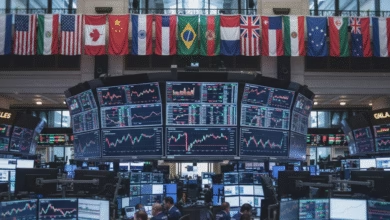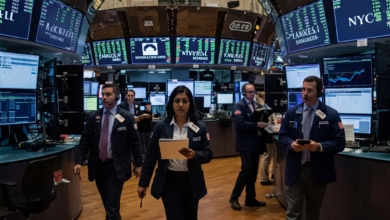What is After-Hours Trading and how does it work?
Find out what time the stock market is open

For most people, the stock market has a clear rhythm, marked by the iconic opening and closing bells. We’re conditioned to think that all the action happens between 9:30 a.m. and 4:00 p.m. Eastern Time. But when the final bell rings and the news anchors summarize the day’s events, the market doesn’t simply go to sleep. A different kind of trading begins, one that operates in the shadows of the main session: after-hours trading.
This extended session is where some of the most dramatic price swings can occur, often in response to breaking news that couldn’t wait for the morning. But what is this mysterious trading period? How does it work, and more importantly, is it a golden opportunity for the average investor or a dangerous trap?
This in-depth guide will pull back the curtain on after-hours trading. We’ll explore the mechanics behind it, the reasons for its existence, and the significant risks every investor must understand before even thinking about participating.
What Exactly Is After-Hours Trading?

After-hours trading, also known as the extended-hours session, is any trading activity that takes place after the major stock exchanges close for the day. The standard U.S. stock market session runs from 9:30 a.m. to 4:00 p.m. ET. The after-hours session typically runs from 4:00 p.m. to 8:00 p.m. ET.
Similarly, there is also a pre-market session, which usually takes place from 4:00 a.m. to 9:30 a.m. ET. Both of these sessions function in a similar way and are often grouped together under the umbrella term “extended-hours trading.”
During these periods, investors can still buy and sell stocks, but the environment is fundamentally different from the regular trading day. The rules of the game change, the number of players dwindles, and the risks increase dramatically.
How Does After-Hours Trading Actually Work?
During the regular session, stock exchanges like the NYSE and NASDAQ act as centralized hubs, matching millions of buy and sell orders from across the globe in a continuous auction. After 4:00 p.m., these main exchanges close, but the trading doesn’t stop.
Instead, it moves to Electronic Communication Networks (ECNs).
Think of an ECN as a digital, members-only auction house. It’s a computerized system that automatically matches buy and sell orders for securities outside of the traditional stock exchanges. In the past, access to these ECNs was the exclusive domain of large institutional investors like investment banks and hedge funds. However, with the rise of modern online brokerages, access has been extended to retail investors as well.
When you place an after-hours trade through your broker, they route your order to one of these ECNs. The ECN then looks for a corresponding order to match yours. For example, if you place an order to buy 50 shares of Company XYZ at $105, the ECN will only execute your trade if it can find another participant on that same network willing to sell 50 shares at $105.
This peer-to-peer matching system is the key reason why the after-hours environment is so different from the regular session.
Why Does Trading Happen Outside of Normal Market Hours?
The primary driver of after-hours trading is news. Many market-moving events occur after the 4:00 p.m. closing bell. Companies do this intentionally to give investors and analysts time to digest the information before the next trading day begins, preventing knee-jerk reactions during the main session.
The most significant catalyst is corporate earnings reports. Most publicly traded companies release their quarterly or annual financial results after the market closes. A company might report better-than-expected profits, causing its stock to surge in after-hours trading. Conversely, a negative report can cause the stock to plummet.
Other major news events that fuel after-hours activity include:
- Merger and acquisition (M&A) announcements.
- Key executive changes (e.g., a CEO stepping down).
- FDA approvals or rejections for pharmaceutical companies.
- Major product announcements or recalls.
- Significant geopolitical events or economic data releases.
Investors use the after-hours session to react to this news instantly, hoping to gain an edge before the rest of the market can join in the next morning.
The Major Risks of After-Hours Trading: Proceed with Extreme Caution

While the idea of getting ahead of the curve is tempting, after-hours trading is a minefield of risks for the average investor. The environment is less stable, less transparent, and far more volatile than the regular session. Here are the critical dangers you must understand.
1. Lower Liquidity
This is the single most important difference. Liquidity refers to the ease with which you can buy or sell a security without affecting its price. During the regular session, millions of participants are trading, meaning there’s almost always someone on the other side of your trade.
In the after-hours session, the number of participants drops dramatically. This lower liquidity means:
- It can be hard to fill your order. You might want to sell a stock, but there simply aren’t enough buyers on the ECN at your desired price.
- You may only get a partial fill. You might place an order to sell 200 shares but only find buyers for 75 of them.
2. Wider Bid-Ask Spreads
The bid-ask spread is the difference between the highest price a buyer is willing to pay (the bid) and the lowest price a seller is willing to accept (the ask). During regular hours, this spread might be a single penny for a popular stock.
In the after-hours session, with fewer participants, the spread can widen significantly. For example, a stock might have a bid of $99.50 and an ask of $100.50. This means:
- If you place a buy order, you’d likely pay $100.50.
- If you place a sell order, you’d likely get $99.50.
Just by entering and exiting a position, you could lose $1.00 per share due to the spread alone. This is a hidden cost that can quickly erode any potential profits.
3. Increased Volatility
Because there are fewer shares being traded, even a relatively small order can cause a huge price swing. A buy order for a few thousand shares that would barely move the needle during the day could cause a stock’s price to jump several percent after hours. This extreme volatility means prices can move against you very quickly, leading to substantial losses.
4. Competition from Institutional Investors
As a retail investor, you are a small fish in a big pond. In the after-hours session, that pond shrinks, and you’re left swimming with sharks. You are competing directly with professional traders at hedge funds and investment banks who have access to more sophisticated tools, better information, and faster execution speeds. They are professionals who trade for a living, and they often have an informational edge.
5. Price Disconnect from the Next Day’s Open
A stock that soars 15% in after-hours trading on good news is not guaranteed to open 15% higher the next morning. Often, the after-hours price reflects an initial, emotional overreaction. By the time the market opens at 9:30 a.m., institutional analysis has been completed, and the broader market sentiment might pull the opening price much closer to the previous day’s close. Chasing after-hours moves is a common way for inexperienced traders to get burned.
How Can a Regular Investor Participate in After-Hours Trading?

If, after understanding all the risks, you still wish to participate, the process is fairly straightforward with most modern brokerages.
- Check Your Broker: First, confirm that your brokerage firm (like Fidelity, Charles Schwab, E*TRADE, or Robinhood) offers extended-hours trading. Most major brokers do, but they may require you to agree to a special disclosure acknowledging the risks.
- Use Limit Orders Exclusively: This is the most important rule. A limit order lets you set the maximum price you’re willing to pay or the minimum price you’re willing to accept. This is non-negotiable in the after-hours market. Using a market order (which executes at the best available price) is incredibly dangerous due to the wide spreads and high volatility. It could result in you paying a far higher price than you ever intended.
- Specify the Session: When placing your trade, you will typically need to select an option for “Order Duration” or “Time-in-Force.” Instead of a standard “Day” order, you’ll choose an option like “Day + Extended Hours” or a similar designation.
Should You Engage in After-Hours Trading? A Final Verdict
For the vast majority of investors, particularly those focused on long-term goals like retirement, the answer is a clear and simple no.
The core principles of successful long-term investing—diversification, patience, and a focus on fundamental value—are the complete opposite of the speculative, high-risk nature of after-hours trading. The potential for a small gain is vastly outweighed by the potential for a swift and significant loss due to low liquidity, high volatility, and wide spreads.
After-hours trading is a tool best left to highly experienced, active traders who have a deep understanding of market dynamics, a high tolerance for risk, and a specific strategy for reacting to news events.
For everyone else, the smartest move is often to read the after-hours news, see how the market digests it, and wait for the stability and liquidity of the regular trading session to return the next morning before making any decisions. The market will still be there, but with a much safer and more level playing field.





